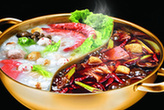Heralded as the largest and highest-grade professional exposition in China, the 12th Beijing China Antique and Artwork Expo was held from November 6 to 9 at the central hall of the China World Trade Center.
Dozens of famous antique and auction companies both from home and abroad participated in the expo, with nearly tens of thousands of exhibits showcased to visitors.
Green-glazed porcelain tripod censer with raised line design from Longquan kiln of the Song Dynasty (960-1297)
Censer evolved from the bronze Ding (typically a three-legged ancient Chinese cooking vessel) of the Shang and Zhou Dynasties (circa 1600 BC-221 BC), which was usually served as a sacrificial vessel. Porcelain censer was initially used in the Wu country in the Dynasty of Three Kingdoms (220-280). The tripod censer had become popular since the Song Dynasty (960-1279).
|
|
This censer has three cloud-shaped legs on the bottom for support. With four lines raised from its body, the censer was enameled with green glaze to make its design more simple and elegant.
Gourd-shaped blue and white porcelain vase decorated with dragon among cloud design made in the Emperor Wanli’s reign of the Ming Dynasty (1368-1644)
This gourd-figured vase is decorated with a dragon among clouds design. Since the emperor Wanli believed in Taoism, a number of porcelain articles made in this era were gourd-shaped.
|
|
The Chinese pronunciation for gourd is “Hulu”, which was written as “壶卢” in ancient Chinese characters. Because 壶 (Hu) was a drinking vessel while 卢 (Lu) was a food vessel in ancient times, gourds were usually considered auspicious symbols related with sacrificial ceremonies and rituals. Gourd-shaped vases originally appeared in the Tang Dynasty (618-907) and gained wide popularity generation by generation due to their elegant style appealing to both refined and popular tastes.





Why not rent a boyfriend, or girlfriend to please parents during the Spring Festival?